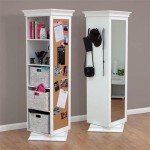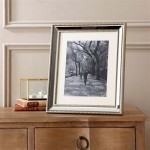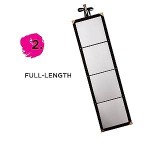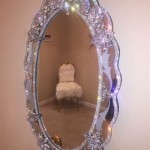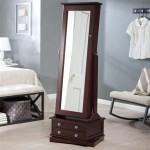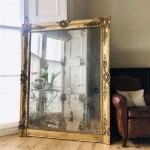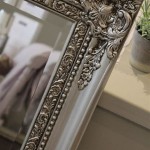How to Make a Tri-Fold Mirror
A tri-fold mirror offers a versatile way to view oneself from multiple angles, proving particularly useful for tasks like applying makeup or styling hair. Constructing a tri-fold mirror is a manageable DIY project requiring readily available materials and basic woodworking skills.
Materials Required:
The construction of a tri-fold mirror necessitates several key materials. Three mirrors of identical size form the core of the project. The size can be adjusted based on individual needs, but ensuring uniformity is crucial for proper alignment. Plywood provides a sturdy backing and frame structure. The thickness of the plywood should be sufficient to support the mirrors' weight and withstand regular use. Hinges are essential for connecting the mirror panels and enabling the folding mechanism. Choose hinges appropriate for the weight and thickness of the mirrors and plywood. Wood glue ensures secure bonding between the mirrors and the plywood backing. Finishing materials, such as paint or wood stain, enhance the aesthetic appeal and protect the wood. Finally, screws are needed to secure the hinges to the plywood and mirrors.
Tools Required:
Several tools facilitate the construction process. A measuring tape or ruler ensures accurate measurements for cutting the plywood and positioning the mirrors. A pencil or marking tool allows for clear markings on the wood. A saw, either hand-held or electric, is necessary for cutting the plywood to the correct dimensions. A drill with appropriately sized drill bits aids in creating pilot holes for screws, preventing wood splitting. A screwdriver, either manual or electric, is used to drive the screws. Safety glasses and gloves are essential for protecting the eyes and hands during the construction process. Clamps can be helpful for holding the mirrors and plywood together while the glue dries.
Step-by-Step Construction:
Step 1: Measuring and Cutting the Plywood: Begin by accurately measuring the dimensions of the mirrors. The plywood backing pieces should be cut to match the width of each mirror. The length of the center plywood piece should match the height of the mirrors. The length of the two side plywood pieces should be equal to the height of the mirrors plus the width of the closed side panels. This allows the side panels to fold inward completely. Cut the plywood pieces according to these measurements.
Step 2: Attaching the Mirrors to the Plywood: Apply a thin, even layer of wood glue to the back of each mirror. Carefully align each mirror with its corresponding plywood piece and press firmly. Secure the mirrors to the plywood using clamps and allow the glue to dry completely according to the manufacturer's instructions.
Step 3: Installing the Hinges: Position the two side mirror panels on either side of the center mirror panel, ensuring they are aligned correctly. Mark the locations for the hinges on both the center and side panels. Drill pilot holes at the marked locations to prevent the wood from splitting. Attach the hinges using screws, ensuring they are securely fastened.
Step 4: Finishing the Mirror: Once the hinges are installed, examine the entire structure for stability. Apply the chosen finish, whether paint or stain, to the exposed plywood surfaces. Allow the finish to dry thoroughly before using the mirror.
Tips and Considerations:
Several factors can influence the success of this project. Selecting high-quality mirrors ensures clear reflections. Using appropriate hinges for the weight and size of the mirrors prevents sagging or instability. Accurate measurements and precise cutting of the plywood are crucial for proper alignment and functionality. Allowing ample drying time for the glue ensures a strong bond between the mirrors and the plywood. Adding decorative elements, such as molding or trim, can personalize the finished product. Consider adding felt pads to the bottom edges of the side panels to protect surfaces from scratches.
Safety Precautions:
Prioritizing safety throughout the project is paramount. Always wear safety glasses when cutting wood or using power tools. Gloves protect hands from splinters and sharp edges. Work in a well-ventilated area when using paint or stain. Dispose of any waste materials properly. Handle mirrors with care to prevent breakage. If using power tools, familiarize yourself with their operation and follow the manufacturer’s safety guidelines.
Alternative Construction Methods:
While the method described utilizes plywood for backing, alternatives exist. Solid wood offers a more robust and aesthetically pleasing option, although it can be more expensive. MDF (Medium-Density Fiberboard) is a cost-effective alternative to plywood, but it may not be as durable. Pre-made frames designed for mirrors can simplify the construction process, eliminating the need to cut and assemble the backing.

C Bryan S Furniture Projects Stickley End Table Diy Vanity Mirror Trifold

The Trifold Mirror Diy Kit

How To Make A Tri Fold Mirror And Triangular Prism Box Stimulating Learning Trifold Diy Preschool

The Trifold Mirror Diy Kit

Made A 3 Way Trifold Mirror On The So Easy Diy Vanity

Haircut System Tri Fold 3 Way Folding Mirror Easy To

Custom Three Panel Mirrors Framed Or Frameless Any Size

3 Way Mirror 360 Trifold With Height Adjustable Telescoping Hooks And 5x Magnification For Makeup Hair Styling Cutting Com

Tri Fold Mirror Book Henbea

Cosmetic Tri Fold Mirror Sd Barber Supply

